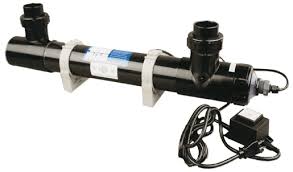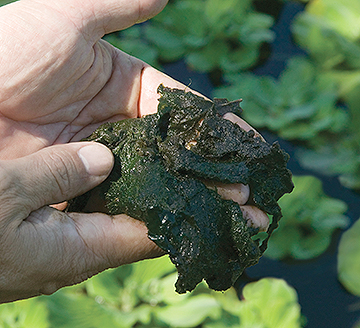No products in the cart.
Ponds and why they are green.
First things first,
The only reason a pond would ever turn green is due to algae growing in it. First, let it be said that algae in a pond is not necessarily bad. In fact, a healthy thin layer of algae growing on the inner surfaces of the pond is an important part of a healthy pond. It can help prevent a high level of nitrates from building up in the pond water by consuming the nitrates as food and giving off oxygen in the process. On the other hand, algae can also be a real problem.
- When the healthy type of algae “blooms” it turns the water anywhere from a slightly cloudy green color to the point where the water is so green that you can’t see two inches into the water.
- When you get the “bad” type of algae which is referred to a filamentous algae in your pond. This type of algae does not necessarily effect the clarity of the water but can grow in clumps or stringy masses to the point that it threatens to overtake the pond.

In the first situation, your pond water, which was once clear, has suddenly turned green. Here is what has happened. The “good or healthy” type algae which usually collects on the sides of the pond and never grows to be more than 1/4″ in length has decided to reproduce or bloom. Similar to how a flower might bloom and give off pollen, this type of algae will suddenly release millions of single cell algae, only 3 microns in size. These cells, while they are alive, are too small for any filter to pick up.
How do you control algae blooms? The easiest and often times, most practical way to solve this problem is to simply install an ultraviolet light on your pond’s filtration system. The way an ultraviolet light works is simple. As the water from the pond flows through the ultraviolet light unit it gets exposed to the light waves emitted from the light inside the unit. These light waves are so intense that they break up the DNA in the algae’s cell thereby killing the algae. Once the algae dies the dead cells start to decompose and then begin sticking to one another. After a number of the dead algae cells collect together, their total mass then becomes large enough for the filter to collect them out of the water or they simply sink to the pond bottom. Once you install an ultraviolet light this process takes about a week before the water becomes clear again.

In the second situation, your pond water may be clear but a green stringy algae reaching 1 to 2 feet long is rapidly beginning to grow on the waterfall and or throughout the pond. This algae may start to become a problem as it breaks loose and begins floating around in the pond. Additionally, as this algae fills the basket, the basket may need to be cleaned almost daily or the will slow down or completely stopping water. In this case, the problem is that you have developed filamentous algae in your pond. This algae is most commonly introduced to a pond when you add plants. If a single spore is on a plant when you place it in your pond you can create this problem.
This “string algae” as it is often referred to comes in many forms. Some grow very quick and are invasive while others grow very slowly. Some forms may not be very obvious at first glance but will grow to about 2 to 3 inches long on the pond walls. With this form of algae you notice the basket walls quickly gets lined with green algae to the point that it affects the water flow of the but the basket itself has very little debris in it. It is impossible for the “good” algae mentioned in the first situation to plug a basket due to it’s small particle size.

(an ultraviolet light)
How do you control filamentous algae? An ultraviolet light will have very little affect on filamentous algae because this type of algae grows on the pond walls and never reaches the uv light. In mild cases you can simply collect the algae off the waterfall or rocks by hand when it becomes unattractive. In severe cases when it becomes very invasive and starts plugging the basket, we recommend using an algae control liquid. We have a product called Algae Control which has worked very well for us. It is a herbicide which means it is a weed killer. When dosed properly it is extremely effective but you need to know how many gallons you have in your pond to properly use it. If you overdose by as little as 20% you can kill your fish. We suggest you under dose the first couple times you use it if you are not sure of the volume of your pond. One or two normal doses will usually kill off the algae. Then, we recommend adding half the recommend dose once every two weeks, rather than once a week, as a maintenance. Always keep your running to help provide oxygen to the pond while treating with this product because as the algae dies, and begins to decompose, it can consume large amounts of oxygen from the water. You need to pay attention when you use this product but it by far the easiest and most effective product we have used to overcome filamentous algae.
Tips concerning ultraviolet lights
- Make sure the uv light you select is properly sized for your pond. A light that is too small for your pond will not effectively clear your pond water.
- Make sure you change the uv lamp once a year. After one year most lamps are operating at only about 60% of their capacity. The lamp might be lit but it will not have the capacity to kill the algae.
- Make sure you do not exceed the recommended flow of water through the unit. If you send the pond water through too fast it will reduce the exposure time to the light thereby, reducing the ability of the light to kill the algae You may need to install a bypass on the unit. This will allow you to control how much water is traveling through the unit. The proper water flow is very important.
- Make sure you have proper circulation in your pond. Is all the pond water circulating together? If you have dead areas in your pond where the water seldom moves, those areas will tend to grow algae and as this water slowly migrates into the pond it will cloud the rest of the water.
- Make sure you operate your filter system 24 hours a day. If you are in the habit of running the only part of the time, you may find keeping the water really clear to be a problem.
- A properly sized uv light coupled with a good filter will give you very clear water all year long with no effort on your part other than changing the lamp once a year. They work so well that we would never build a pond without installing an ultraviolet light.

